Jeans
Jeans are a type of pants or trousers, typically made from denim or dungaree cloth. Often the term "jeans" refers to a particular style of trousers, called "blue jeans", which were invented by Jacob W. Davis in partnership with Levi Strauss & Co. in 1871[1] and patented by Jacob W. Davis and Levi Strauss on May 20, 1873. Prior to the Levi Strauss patented trousers, the term "blue jeans" had been long in use for various garments (including trousers, overalls, and coats), constructed from blue-colored denim.[2]
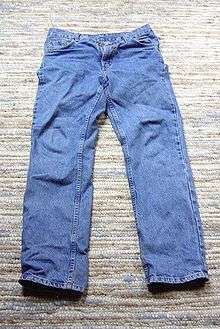
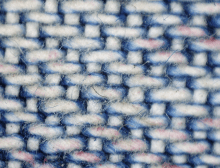
"Jean" also references a (historic) type of sturdy cloth commonly made with a cotton warp and wool weft (also known as "Virginia cloth"). Jean cloth can be entirely cotton as well, similar to denim. Originally designed for miners, modern jeans were popularized as casual wear by Marlon Brando and James Dean in their 1950s films, particularly The Wild One and Rebel Without a Cause,[3] leading to the fabric becoming a symbol of rebellion among teenagers, especially members of the greaser subculture. From the 1960s onwards, jeans became common among various youth subcultures and subsequently young members of the general population. Nowadays, they are one of the most popular types of specialty trousers in Western culture. Historic brands include Levi's, Lee, and Wrangler.
History
Fabric
Research on the trade of jean fabric shows that it emerged in the cities of Genoa, Italy, and Nîmes, France. Gênes, the French word for Genoa, may be the origin of the word "jeans". In Nîmes, weavers tried to reproduce jean fabric but instead developed a similar twill fabric that became known as denim, from de Nîmes, meaning "from Nîmes". Genoa's jean fabric was a fustian textile of "medium quality and of reasonable cost", very similar to cotton corduroy for which Genoa was famous, and was "used for work clothes in general". The Genoese navy equipped its sailors with jeans, as they needed a fabric which could be worn wet or dry.[4][5] Nîmes's "denim" was coarser, considered higher quality, and was used "for over garments such as smocks or overalls".[6] In 1576 a quantity of "jean fustians" arrived into the port of Barnstaple on a vessel from Bristol.[7] Nearly all indigo, needed for dyeing, came from indigo bush plantations in India until the late 19th century. It was replaced by indigo synthesis methods developed in Germany.[8]
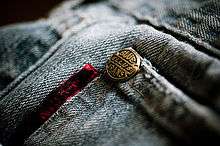
By the 17th century, jean was a crucial textile for working-class people in Northern Italy. This is seen in a series of genre paintings from around the 17th century attributed to an artist now nicknamed The Master of the Blue Jeans.[9] The ten paintings depict impoverished scenes with lower-class figures wearing a fabric that looks like denim. The fabric would have been Genoese jean, which was cheaper. Genre painting came to prominence in late 16th century, and the non-nobility subject matter in all ten paintings places them among others that portray similar scenes.[10]
Dungaree was mentioned for the first time in the 17th century, when it was referred to as cheap, coarse thick cotton cloth, often colored blue but sometimes white, worn by impoverished people in what was then a region of Bombay, India a dockside village called Dongri. This cloth was "dungri" in Hindi. Dungri was exported to England and used for manufacturing of cheap, robust working clothes. In English, the word "dungri" became pronounced as "dungaree".[11]
Rivets

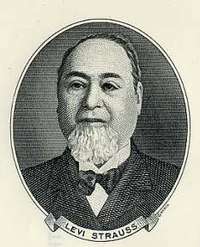
The term jeans appears first in 1795, when a Swiss banker by the name Jean-Gabriel Eynard and his brother Jacques went to Genoa and both were soon heading a flourishing commercial concern. In 1800 Massena's troops entered the town and Jean-Gabriel was entrusted with their supply. In particular he furnished them with uniforms cut from blue cloth called "bleu de Genes" whence later derives the famous garment known worldwide as "blue jeans".[12]
Levi Strauss, as a young man in 1851, went from Germany to New York to join his older brothers who ran a goods store. In 1853, he moved to San Francisco to open his own dry goods business. Jacob Davis was a tailor who often bought bolts of cloth from the Levi Strauss & Co. wholesale house. In 1872, Davis wrote to Strauss asking to partner with him to patent and sell clothing reinforced with rivets.[13] The copper rivets were to reinforce the points of stress, such as pocket corners and at the bottom of the button fly. Levi accepted Davis's offer,[14] and the two men received US patent No. 139,121 for an "Improvement in Fastening Pocket-Openings" on May 20, 1873.[15]
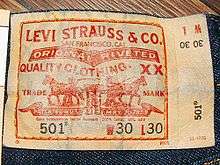
Davis and Strauss experimented with different fabrics. An early attempt was brown cotton duck, a bottom-weight fabric.[lower-alpha 1] Finding denim a more suitable material for work-pants, they began using it to manufacture their riveted pants. The denim used was produced by an American manufacturer. Popular legend incorrectly states that it was imported from Nimes, France. A popular myth is that Strauss initially sold brown canvas pants to miners, later dyed them blue, turned to using denim, and only after Davis wrote to him, added rivets.[13]
Initially, Strauss's jeans were simply sturdy trousers worn by factory workers, miners, farmers, and cattlemen throughout the North American West.[16][17] During this period, men's jeans had the fly down the front, whereas women's jeans had the fly down the left side.[18] When Levi Strauss & Co. patented the modern, mass-produced prototype in the year 1873, there were two pockets in the front and one on the back right with copper rivets.[12] The small riveted watch pocket was first added by Levi Strauss to their jeans in the late 1870s.[19]
20th century evolution
In 1901 Levi Strauss added the back left pocket to their 501 model.[20] This created the now familiar and industry standard five pocket configuration with two large pockets and small watch pocket in front with two pockets on the rear.
Fewer jeans were made during World War II, but 'waist overalls' were introduced to the world by US soldiers, who sometimes wore them off duty.[21][22] By the 1960s, both men's and women's jeans had the zipper down the front. Historic photographs indicate that in the decades before they became a staple of fashion, jeans generally fit quite loosely, much like a pair of bib overalls without the bib. Indeed, until 1960, Levi Strauss called its flagship product "waist overalls" rather than "jeans".
After James Dean popularized them in the movie Rebel Without a Cause, wearing jeans became a symbol of youth rebellion during the 1950s.[23][24] During the 1960s the wearing of jeans became more acceptable, and by the 1970s it had become general fashion in the United States for casual wear.[25] However, the acceptance of jeans as casual wear is still relatively low in Japan.[26]
Examples of intentional denim distressing strictly to make them more fashionable can be seen as early as 1935 in Vogue's June issue.[27] Michael Belluomo, editor of Sportswear International Magazine, Oct/Nov 1987, P. 45, wrote that in 1965, Limbo, a boutique in the New York East Village, was "the first retailer to wash a new pair of jeans to get a used, worn effect, and the idea became a hit." He continued, "[Limbo] hired East Village artists to embellish the jeans with patches, decals, and other touches, and sold them for $200." In the early 1980s the denim industry introduced the stone-washing technique developed by GWG also known as "Great Western Garment Co." Donald Freeland of Edmonton, Alberta pioneered the method,[28] which helped to bring denim to a larger and more versatile market. Acceptance of jeans continued through the 1980s and 1990s. Originally an esoteric fashion choice, in the 2010s jeans may be seen being worn by men and women of all ages.[29]
Manufacturing processes
Dyeing

Traditionally, jeans were dyed to a blue color using natural indigo dye. Most denim is now dyed using synthetic indigo. Approximately 20 thousand tons of indigo are produced annually for this purpose, though only a few grams of the dye are required for each pair.[30] For other colors of denim other dyes must be used. Currently, jeans are produced in any color that can be achieved with cotton.
For more information on dyeing, refer to denim and the discussion there of using pigment dyes.
Pre-shrinking

In 1962 Levi Strauss introduced their own pre-shrunk jeans (Lee and Wrangler jeans had already long been pre-shrunk); these did not shrink further after purchase, allowing the consumer to purchase a correctly fitting size. Pre-shrink is most common in jeans nowadays.[31] These jeans were known as the 505 regular fit jeans. The 505 are almost identical to the 501s with the exception of the button-fly. The Levi's Corporation also introduced a slim boot-cut fit known as 517 and 527. The difference between the two is the 517s sit at the waist line and the 527s sit below the waist line. Later, Levi's would develop other styles and fits such as the loose, slim, comfort, relaxed, skinny, and a regular fit with a tapered leg.
Used and distressed looks

The used or "acid wash" look is created by means of abrading the jeans and/or treating them with chemicals, such as acryl resin, phenol, a hypochlorite, potassium permanganate, caustic soda, acids etc.[32]
Ripping or distressing of jeans, though also arising naturally as a result of wear and tear, is sometimes deliberately performed by suppliers - with distressed clothing sometimes selling for more than a nondistressed pair. For example, Pucci sold "embellished mid-rise boyfriend jeans" for £600 (US$860).[33]
Sandblasting or abrading with sandpaper
Consumers wanting jeans that appear worn can buy jeans that have been specially treated. To give the fabrics the worn look, sandblasting done with chemicals or by adding pumice stone to the washing process or abrading with sandpaper is often done.
Environmental and humanitarian impact
A typical pair of blue jeans uses 919 gallons (3479 liters) of water during its life cycle. This includes the water to irrigate the cotton crop, manufacture the jeans, and the numerous washes by the consumer.[34]
The production of jeans with a "used look" can be more environmentally damaging than regular jeans,[35] depending on how the waste compounds are processed. Sandblasting and treating with sandpaper has the risk of causing silicosis to the workers, and in Turkey, more than 5,000 textile workers have been stricken with this disease, and 46 people are known to have died. Some companies have announced they are banning the use of sandblasting.[36]
Care and wear
Despite most jeans being "pre-shrunk", they are still sensitive to slight further shrinkage and loss of color from being washed. The Levi Strauss company recommends avoiding washing jeans as much as possible. Carl Chiara, Levi Strauss director of brand and special projects, has a credo: The less you wash your jeans, the better your jeans become.[37] These and other suggestions to avoid washing jeans where possible have encountered criticism. Cory Warren, editor of LS&Co. Unzipped, clarifies in a response to such a criticism:
Our advice is to wash less often, but clearly, you have to judge for yourself what's appropriate. Hot day, dirty job? Wash your jeans. Please! Cold day, office job? Maybe you can wear them twice or more before they go back to the washing machine. Personally, if I wear a pair of jeans to work on Friday—cool climate, office job—I tend to wear them on Saturday. And if Saturday is spent indoors and I'm not spilling food all over myself, I might even wear them on Sunday.
— Corey Warren[37]
For those who prefer to refrain from washing their jeans there have been suggestions to freeze them in order to kill the germs that cause odor. However, this advice has been proven ineffective.[38] (120 °C).
Legal cases
Italian rape trial
In Rome, Italy, in 1992, a 45-year-old driving instructor was accused of rape. When he picked up an 18-year-old girl for her first driving lesson, he allegedly raped her for an hour, then told her that if she was to tell anyone he would kill her. Later that night she told her parents and her parents agreed to help her press charges. While the alleged rapist was convicted and sentenced, the Italian Supreme Court overturned the conviction in 1998 because the victim wore tight jeans. It was argued that she must have necessarily had to help her attacker remove her jeans, thus making the act consensual ("because the victim wore very, very tight jeans, she had to help him remove them ... and by removing the jeans ... it was no longer rape but consensual sex"). The Italian Supreme Court stated in its decision "it is a fact of common experience that it is nearly impossible to slip off tight jeans even partly without the active collaboration of the person who is wearing them."[39]
The ruling sparked widespread feminist protest. The day after the decision, women in the Italian Parliament protested by wearing jeans and holding placards that read "Jeans: An Alibi for Rape". As a sign of support, the California Senate and Assembly followed suit. Soon Patricia Giggans, Executive Director of the Los Angeles Commission on Assaults Against Women, (now Peace Over Violence) made Denim Day an annual event. As of 2011 at least 20 U.S. states officially recognize Denim Day in April. Wearing jeans on this day has become an international symbol of protest against such attitudes about sexual assault. As of 2008 the Italian Supreme Court has overturned their findings, and there is no longer a "denim" defense to the charge of rape.
Indian divorce case
In 2014, an Indian family court in Mumbai ruled that a husband objecting to his wife wearing a kurta and jeans and forcing her to wear a sari amounts to cruelty inflicted by the husband and can be a ground to seek divorce.[40] The wife was thus granted a divorce on the ground of cruelty as defined under section 27(1)(d) of Special Marriage Act, 1954.[40]
Trends
Worldwide market for jeans
North America accounts for 39% of global purchases for jeans, followed by Western Europe at 20%, Japan and Korea at 10% and the rest of the world at 31%.[41]
United States consumers spent more than US$14 billion on jeans in 2004 and US$15 billion in 2005.[42] US consumers bought US$13.8 billion of men's and women's jeans in the year that ended April 30, 2011, according to market-research firm NPD Group.[43]
Jeans in the USSR
In the Soviet Union, jeans were the symbol of the Western way of life. The "jeans fever" in the USSR started in 1957 during the World Festival of Youth and Students.[44] According to a 1961 Russian textile dictionary, jeans were initially referred to as a "worker's uniform" (рабочий костюм, rabochii kostyum).[45]
The jeans brand Rokotov and Fainberg is named after the defendants in the Rokotov–Faibishenko case, who were executed for, among other things, trafficking in jeans.[44]
Although not outright banned, jeans were hard to come by in USSR. It was seen as a symbol of rebellion by the Soviet youth who wanted to emulate the style of film and rock stars of the West. The Soviet government resisted supplying the market with jeans as that would mean responding to the market, a capitalist principle.[46] People went to great lengths, sometimes resorting to violence and other illegal activities to obtain real Western made jeans. This led to the creation of black markets and bootlegging of jeans, which since has become an important cultural element in the history of the Soviet Union.[47]
Market-share shift to activewear
In 2014, teens were buying more fashion and athleisure clothing from brands such as Nike and Lululemon over denim classics from brands like Abercrombie & Fitch.[48] Activewear in 2014 comprised 28% of teens' apparel purchases, up from 6% in 2008. In 2014, Nike, Lululemon, Under Armour, and Adidas were the most popular brands for athletic apparel among teen consumers. Fashion retailers have begun to adjust their offerings accordingly. Bloomberg reports that Levi's stuck to its core product (denim) instead of adapting to consumer trends. As a result, Levi's sales decreased from over USD 7 billion to USD 4.8 billion in 2015.[49]
Variations on the basic type
- Cigarette - designed to fit quite closely, but not tightly, to the thigh area, with a less close fit to the calf [50]
- Cropped - where the leg is cut to a lesser length, to somewhere above the ankle [50]
- Relaxed [50]
- Skinny - for people whose bodies are more svelte (thin), additionally worn to flatter the figure in the fashion of tight or close fitting [50]
- Straight [50]
- Wide-leg; or with cropped variant - the waist line rides up past the wearers actual waist, material below the knee is altogether away from the leg and descends as a straight line, standard type descends down to the ankle; cropped variant: the leg ceases at the lower leg mid-way down (or stops further down toward the ankle) [50]
Distressed jeans
.jpg)
Distressed denim emerged from the cultural punk movement in the 1970s. Early punks tore apart consumer goods as an expression of their anger towards society.[51] Johnny Rotten of the Sex Pistols manifested the British punk ideology, which was fighting against the status quo. Denim became a key target of this politically fueled deconstruction, with both men and women donning torn pants and jackets, accessorized with safety pins and slogans. The trend became popular again in the 1990s with the emergence of grunge fashion. If punk was "anti-fashion", grunge was "non-fashion". The grunge youth wore loose-fitting ripped jeans, flannel shirts or woolen Pendletons layered over T-shirts. Their anti-conformist approach to fashion led to the popularization of the casual chic look, a trend which continued into the 2000s.
Low-rise jeans
Media reported in 2017 that the trend of low-rise jeans, famous in 1990s and 2000s as sagging, was coming back in fashion due to celebrities like Justin Bieber endorsing it.[52] Low-rise jeans are usually worn 2-3 inches or more below the navel.[53]
Industrial production
- How denim fabric is stored in the factory.
 Automated cutting machines are used in RMG factory to cut the pieces.
Automated cutting machines are used in RMG factory to cut the pieces. P P Spray and P P Sponging being applied to jeans to give them a new look.
P P Spray and P P Sponging being applied to jeans to give them a new look. Adding 3D crunching, whiskers, and wrinkles to jeans to make them look more used.
Adding 3D crunching, whiskers, and wrinkles to jeans to make them look more used.- Applying permanent wrinkles to jeans.
- Hand scraping of jeans.
- Resin treatment process on jeans.
- Tacking on jeans (adds strength to high-stress areas).
- Socks dyeing machine in a washing plant for washing jeans.
 The process of washing and drying jeans.
The process of washing and drying jeans. The final steps of preparing jeans for market.
The final steps of preparing jeans for market.- Checking the fit on a live model.
- Quality checking and quality assurance.
- Jeans denim pants are displayed for the buyer in the RMG factory showroom.
See also
- Athleisure
- Baggy jeans
- Daisy Dukes
- Denim skirt ("jean" skirt)
- Designer jeans
- Drainpipe jeans
- Jeggings
- Mom jeans
- Western fashion
- Trousers as women's clothing
- Jorts
Notes
- Bottom weight fabric is a heavier fabric suitable for pants or skirts (a.k.a. bottoms). Not necessarily a thick or heavy fabric but heavier than something that would be used to make a blouse or shirt.
References
- Loverin, Jan (2006). "A Nevada Stylist: Your Denim Jeans Are a Nevada Invention" (PDF). Nevada State Museum Newsletter. 36 (3): 4. Archived from the original (PDF) on April 29, 2013. Retrieved January 29, 2015.
- See, e.g., The Richmond Enquirer (Richmond, VA) March 25, 1823, wherein a paid notice described the ready-made apparel stolen by a thief : FIFTY DOLLARS REWARD, FOR JEREMIAH, or as he is commonly called Jerry Hatcher, lately a convict of the Penitentiary, who on the night of the 17th February last did break through my store and carry off a variety of goods, together with about $20 in change and some ready made clothing, and has made his escape. He is about 4 1/2 or 5 feet high, stout and very well made, with light hair, and I expect has on blue Jeans coatee and brown pantaloons, as he took such from me and has been seen with them on. I expect he is either in Richmond, Petersburg or Lynchburg. Any person who will apprehend said Hatcher and deliver him to me, will meet with my thanks, and the above reward. BRIGHTBERRY BROWN [,] Red Mills, Buckingham [County, Virginia], March 14.
- "The fascinating, tumultuous history of a fashion classic". Vice.
- Howard, Michael C. (February 17, 2011). Transnationalism and Society: An Introduction. McFarland. ISBN 9780786486250.
- "Jeans". facweb.cs.depaul.edu. Retrieved August 14, 2017.
- Gruber, Gerlinde (2010). The Master of the Blue Jeans: A New Painter of Reality in Late 17th Century Europe. Paris: Galerie Canesso. p. 23.
- National Archives (February 18, 1576). "Import and Export books for the Port of Barnstaple".
- "Read More". Ingenious.org.uk. Archived from the original on March 4, 2016. Retrieved October 28, 2015.
- Gruber, Gerlinde (2010). The Master of the Blue Jeans: A New Painter of Reality in Late 17th Century Europe. Paris: Galerie Canesso. p. 10.
- Welch, Evelyn (2005). Shopping in the Renaissance: Consumer Cultures in Italy 1400–1600. New Haven: Yale University Press. p. 44.
- William, Carrie (September 3, 2017). "Origin and History of Dungaree Fabric". Historyofjeans.com. Retrieved October 28, 2015.
- Sullivan, J. (2006). Jeans: A cultural history of an American icon. New York: Gotham Books
- Downey, Lynn (2007). "A Short History of Denim" (PDF). official Levi Strauss & Co. historian. Retrieved June 2, 2014.
- Wagman-Gellar, Marlene (2010). Eureka!: The Surprising Stories Behind the Ideas That Shaped the World, Eureka #3 (1871) (unpaginated). Penguin Group (USA), Inc. Retrieved October 2, 2011.
- U.S. Patent 139,121
- Hobson, J. (July 1, 2013). "To die for? The health and safety of fast fashion". Occupational Medicine. 63 (5): 317–319. doi:10.1093/occmed/kqt079. ISSN 0962-7480. PMID 23837074.
- "A History Of Blue Jeans: From Miners' Wear to American Classic - Nature and Community - MOTHER EARTH NEWS". Mother Earth News. Retrieved March 17, 2017.
- "Style: August 2015". New Orleans Living Magazine. Retrieved March 17, 2017.
- "Small pocket on your pants and jeans: Here's what it's for - Insider".
- "Pockets Full of History - Levi Strauss & Co".
- "The History of Jeans". newint.org. Archived from the original on March 17, 2017. Retrieved March 17, 2017.
- Fitzgerald, Benjamin. "Denim: History of Jeans & American Culture". Le Souk. Retrieved February 24, 2019.
- Lauren Cochrane and Helen Seamons. "James Dean: an enduring influence on modern fashion | Fashion". The Guardian. Retrieved October 28, 2015.
- Schober, Anna (2001). Blue Jeans. Vom Leben in Stoffen und Bildern. Frankfurt/ New York: Campus.
- Smith, Nancy MacDonell (2003). The Classic Ten:poella grande y gruesa The True Story of the Little Black Dress and Nine Other Fashion Favorites. Penguin. p. 42. ISBN 978-0-14-200356-5. Retrieved January 13, 2011.
- "女生七嘴八舌嚷「解放」 老教授硬是不准入課堂". The Kung Sheung Daily News. May 27, 1977. Retrieved February 25, 2019.
- "De Nimes". vice.com. Retrieved May 30, 2017.
- "Levi's By the Numbers (Men's)". Worldflow Knowledge. Archived from the original on May 8, 2009. Retrieved December 31, 2010.
- Katya Foreman (April 1, 2015). "Jean genie: The denim evolution".
- Elmar Steingruber "Indigo and Indigo Colorants" Ullmann's Encyclopedia of Industrial Chemistry 2004, Wiley-VCH, Weinheim. doi: 10.1002/14356007.a14_149.pub2
- "Levi Strauss & Co. Timeline" (PDF). Archived from the original (PDF) on October 9, 2012. Retrieved November 23, 2012.
- Der preis der Bluejeans documentary by Studio Hamburg 2012
- Laura Craik (March 8, 2014), "Am I too old for ... ripped jeans?", The Times: 11
- Kaufman, Leslie (November 1, 2011). "Tim Tries to Minimize Water Use". NYTimes.com. Retrieved March 10, 2012.
- "jeans". ecowatch.
- "Sandblasted jeans: Should we give up distressed denim?". BBC News. September 30, 2011.
- "Wash My Jeans? Hardly". LS&CO. UNZIPPED. July 30, 2012. Archived from the original on September 11, 2010.
- "History, Travel, Arts, Science, People, Places | Smithsonian". Blogs.smithsonianmag.com. Retrieved October 28, 2015.
- Faedi, Benedetta (2009). "Rape, Blue Jeans, and Judicial Developments in Italy". Columbia Journal of European Law. Archived from the original on August 28, 2011. Retrieved April 26, 2011.
- PTI (June 28, 2014). "Wife's jeans ban is grounds for divorce, India court rules". GulfNews.com. Retrieved October 28, 2015.
- "World Denim Market – A Report on Capacities, Market Size, Forecasts etc". Denimsandjeans.com. October 13, 2009. Retrieved October 28, 2015.
- Sullivan, James (August 17, 2006). Jeans: A Cultural History of an American Icon. London: Gotham Books. ISBN 978-1-59240-214-4. OCLC 62697070.
- Binkley, Christina (July 7, 2011). "How Can Jeans Cost $300?". Wall Street Journal.
- Rudevich, Alexei. Worth going to prison for: Getting hold of jeans in the USSR. Russia Beyond the Headlines, September 16, 2014. Accessed on November 16, 2014.
- Rabinowitch, Z.E. (1961). Lupandin, K.K. (ed.). English-Russian Textile Dictionary (Second Edition, Revised and Englarged ed.). Central Editorial Board, Foreign-Language Scientific and Technical Dictionaries, Fizmatgiz. p. 247.
- "Soviet Denim Smuggling - Jeans Behind the Iron Curtain". Heddels. September 14, 2014. Retrieved October 13, 2017.
- Dazed (August 19, 2016). "Exploring the USSR's underground obsession with Levi's 501s". Dazed. Retrieved October 13, 2017.
- Retail (April 9, 2014). "How Teens Are Spending Money". Business Insider. Retrieved October 28, 2015.
- Ashley Lutz (October 11, 2015). "A longtime American wardrobe staple is in danger of extinction". AOL. Retrieved October 28, 2015.
- Adhav, Lauren. "Types of jeans". Cosmopolitan. Hearst Magazine Media, Inc February 21, 2019.
- "Distressed denim: a history".
- "Are You Ready for the Return of Low-Rise Jeans?". The Fashion Spot. August 13, 2013. Retrieved January 26, 2018.
- "10 Types of Jeans". Rated Star. December 23, 2017. Retrieved June 2, 2018.
External links
| Wikimedia Commons has media related to Jeans. |